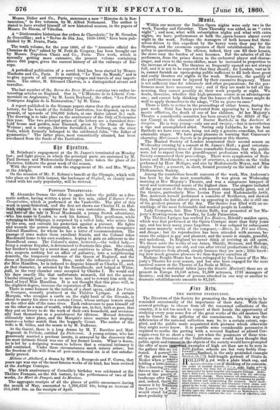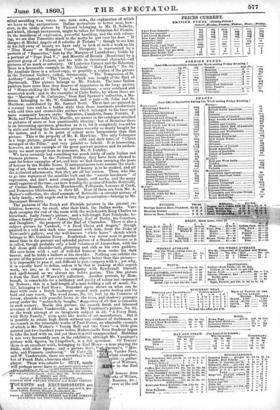lint Arts.
THE BRITISH INSTITUTION.
The Directors of this Society for promoting the fine arta require to be reminded occasionally of the importance of their duty. With their avowed privilege to choose from all the renowned collections of the country, it is not too much to expect at their hands the opportunity of studying every year some few of the great works of the old masters that can be found in the galleries of the connoisseurs. In this way the deficiencies of the national collection may be, to a certain extent, sup- plied, and the public made acquainted with pictures which otherwise they might never know. It is possible some considerable persuasion is required to soothe the parting with a revered Raphael or adored Cor- reggio even for so short a time - yet when the possessors of these trea- sures are the Directors of the Institution one would have thought that public spirit and interestin the objects of the society, would haveprompted
the offer of more i examples of high art than are to be seen in
the gallery this eke left Bat talian schools are but very feebly illus- . ressEis- „Raphael, is the only pretended example D.ssss,65.1,11 half-length portrait of Giulio de Ti OLLOWA rul with a plain black cap, and if thinking of its contents.
the cause of mental depress...A.— side light vsssli dered stomach the long list of gloomy emit*, ana are succeeded by more hopeful and happier feelings. Hollo- way's Pills have been renowned far and wide for effecting this desirable change. They remove all obstructions, regu- late all secretions, and correct depraved humours by purify ing the blood and invigorating the stomach. Their medi- cinal virtues reach, relieve, and stimulate every organ and gland In the body, whereby the entire system is renovated. No medicine ever before discovered acts so directly and bene- ficially upon the blood and circulation as Holloway's cele- brated Ptlis which combine the rare merits of efficiency and harmlessness.
trated. A portrqt the. of the great me Thom Medici when ye holding a lettek'ssa.ter. The colouring.gMag throws most O. Decayed tone of the piellrig. landscape after So. its and, indeed, thus the nounce it by R4e,Iteeth the Louvre by F. free. would stand for;,a; most probably I'S urinal mouldincrreit. VELIA. aux. Bum. KIRA, the explanation of which we leave toth ' anfirarians. Italian portraiture is better seen, how- ever, in the ble picture by Tintoret belonging to Mr. IL Sotheby, and which,hough anonymous, might be taken for Sebastian del Piombo. In the manliness of expression, powerful handling, and the rich colour- ing, we see that Tintoretto stuck to the motto he put over his door " Il disefno di Michel Angelo ed it colorito di Tiziano " ; though to see him in his full sway of beauty we have only to look at such a work as his " Nine Muses " at Hampton Court. Giorgione is represented by a portrait of "Sansovino," lent by the Marquis of Lansdowne; Guido by a portrait of " Pope Paul V.," and Moretto of Brescia (Bonvicino) by a portrait group of a Podesta and his wife in devotional character-all pictures of no mark or notoriety. Of Ludovico Caracci and the Eclectics, there is a favourable example in Mr. Nichols' " Holy Family" No. 54. By Annibale there is a school-copy, or possibly a replica of the picture in the Nafional Gallery, called, erroneously, " The Temptation of St. Anthony" instead of "The Vision," which was bought of the Earl of Dartmouth. This picture belongs to Mr. Nichols. The later Italian painters have more than they deserve of importance in the large picture of " Moses striking the Rock,' by Luca Giordano, a very confused and mannered work ; and in the examples of Carlo Dolce, by whom there are the "Marriage of St. Catherine," from Earl Spencer's collection, a Ma- donna belonging to Mr. W. Goldsmid, and a pair -St. John and St. Matthew, contributed by Mr. Samuel Scott. These last are painted in a warmer tone and in a bolder style than those inanimate productions with cold tints and enamel-like surface which belonged to his later and more commonly known style. Salvatore, Canaletto, Sasso Ferrato, F. Mole, and Timoteo della Vite, Murillo, are names in the catalogue attached to pictures of more or less questionable identity ; but of Bronzino there is an interesting specimen, graceless as it is, for it completely resembles in style and feeling the Beaucousin picture recently so dearly bought for the nation, and it is in point of colour more harmonious than that picture. This is the property of Mr. E. Hawkins. The only Velasquez is a large picture, painted in a very cold and dark tone, of " Christ scourged at the Pillar," and very painful to behold. It is interesting, however, as a rare example of the great portrait painter, and its authen- ticity we must accept from its possessor, Mr. S. Lumley. We have certainly had something too much lately of early Italian and German pictures. In the National Gallery they have been allowed to oust far better examples of art, and here we find them usurping the posts of honour in the Middle Room. If antiquarianism is to assume the teach- ing of art, these works are useful, but if beauty is to be studied, and all the technical adornments, then they are all but useless. Those who like to go into raptures at the saintlike look and the " ascetic loveliness " of expression, and don't mind cramped hands, stiff necks, and the many small vagaries of the time, can here worship the genius of Sandro Botticelli, of Cosimo Rosselli, Zenobio Macchiavelli, Pollajuolo, Lorenzo di Credi, a holy family, with angels and in very fine preservation-belongs to Mr. and Domenico Ghirlandaio, to their fill. Most of them are from. Mr. A. Davenport Bromley.
Barker's collection, the chief example of Botticelli-a circular picture of -- - _.
The pictures of the Dutch and Flemish painters in the preint ex- hibition, however, far excel, after their kind, the Italian works. Van- dyck occupies the end of the room with the we'd-known King Charles on horseback, Lady Jersey's picture ; and a full-length Earl Pembroke, be- sides a family picture of " James Stanley, Earl of Derby, his Countess, and Daughter," the property of the Earl of Clarendon. There is also a subject picture by Vandyck, " A Dead Christ and Angels," though painted in a cold and dark tone unusual with him, from the Duke of Newcastle's gallery, and the well-known "white horse" sketch which belongs to Mr. Gambier Parry. Rembrandt was never seen in grander mood than in the portrait and splendid picture of a Standard-bearer as it is called, though probably only a bold volunteer of Amsterdam, with his full dress gold shoulder-belt, glittering and rich as his own guilders. His eyes beam with a sort of well-fed humour from under his dark beaver, and he holds a halbert at his shoulder. Nothing can exhibit the power of the painter's art over common objects better than this picture- it is impossible to pass it, and difficult to part company with it ; yet why, it is equally hard to define, unless it be that in looking at this superb work, we are, as it were, in company with Rembrandt himself, and spell-bound as we always are before genius. This fine picture is from the Earl of Warwick's collection. Another portrait, by Rem- brandt, is remarkable for a brilliancy and purity of colour not surpassed by Rubens ; this is a half-length of a man holding a roll of music, No. 117, belonging to Earl Howe. Ruysdael again shows us what can be done with even a Dutch landscape treated with poetic feeling and his bold and easy touch. The wood scene, No. 59, lent by the Countess of Jersey, abounds with graceful forms in the trees, and shadowy passages away under the "melancholy boughs," truggestive of all that is romantic in such scenery. Beside this picture, the smooth finish and laboured accuracy of Adrian Vandervelde, as in Mr. Vansittart's picture, No. 62, or the weak attempt at an imaginary subject in 52, "A Ferry Boat, with Holy Family," seem quite like works of art manufacture. But it is possible to attain high finish without any evidence of feebleness, as we remark in the inimitable works of Paul Potter, an admirable example of which is Mr. Walter's " Young Bull and two Cows "-a little gem
painted just two hundred years before Mademoiselle Rosa Bonheur began to take the lead with us, and yet there it is still unapproached. Hobbima is not very favourably seen in the exhibition, although Mr. Vansittart's picture with figures, by Lingelback, is a fair specimen. Of Teniers' there is an excellent work, belonging to Earl Howe-a man playing the
fiddle, with other figures; and a picture from 1,- pencer's, " Her- mits, and Peasants confessing." Of Cuvr,41g D s, Vander Neer, and W. Vandervelde' there are SCVerflinaVbe had .rtant examples;
but of Frank Hals, abraviira sketel- pirit-a guitar- blayer. Those who admire LP" SUIT, made er of Watteau, will perhaps never have . _... P-Aannifor:Zetlaudig-teerd in the Earl
,....aiWooiriiikle:gegiN: the mZcomfortable and service- ,..- able suit ever introduced. Price, from 83s. To be obtained
of E. MOSES and SON, Corner of M1NORLES and ALDGATE, and Corner of NEW OXFORD STREET and HART STREET.
TOURISTS and EXCURSIONISTS are specially provided for at E. MOSES and SON'S, Mer- chant Tailors, Hatters, Hoelers, Bootmakers, &c.
Corner of MINORIES and ALDGATE, and
Corner of NEW OXFORD STREET and HART STREET r BRADFORD and SHEFFIELD, YORKSHIRE.
honour done orks of Wilson, , Romney, ite.; over at the end t.



























 Previous page
Previous page